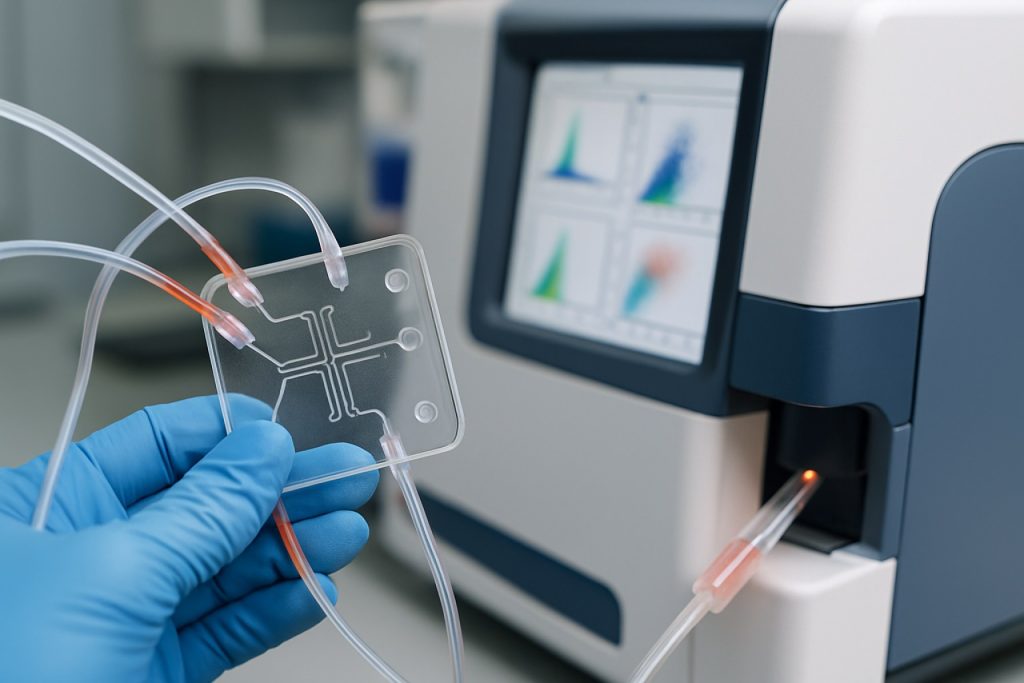
Microfluidic Flow Cytometry Systems in 2025: Transforming Cell Analysis with Miniaturization and High-Throughput Innovation. Explore Market Dynamics, Technology Breakthroughs, and Strategic Opportunities Shaping the Next Five Years.
- Executive Summary: Key Trends and Market Drivers in 2025
- Market Size, Segmentation, and 2025–2030 Growth Forecast (18% CAGR)
- Technology Landscape: Microfluidic Innovations and Integration
- Competitive Analysis: Leading Companies and Emerging Players
- Application Spectrum: From Clinical Diagnostics to Drug Discovery
- Regulatory Environment and Industry Standards
- Strategic Partnerships, M&A, and Investment Activity
- Regional Insights: North America, Europe, Asia-Pacific, and Beyond
- Challenges, Barriers, and Risk Factors
- Future Outlook: Disruptive Trends and Opportunities Through 2030
- Sources & References
Executive Summary: Key Trends and Market Drivers in 2025
Microfluidic flow cytometry systems are poised for significant growth and transformation in 2025, driven by advances in miniaturization, integration, and automation. These systems, which combine the analytical power of traditional flow cytometry with the precision and efficiency of microfluidic technology, are increasingly being adopted across clinical diagnostics, life sciences research, and point-of-care (POC) testing. The convergence of these technologies is enabling faster, more cost-effective, and portable solutions, addressing longstanding challenges in sample handling, reagent consumption, and instrument footprint.
A key trend in 2025 is the rapid commercialization of compact, user-friendly microfluidic flow cytometers. Leading manufacturers such as Becton, Dickinson and Company (BD) and Sony Corporation are expanding their portfolios to include benchtop and portable devices that leverage microfluidic chips for high-throughput single-cell analysis. These systems are designed to reduce operational complexity and enable broader adoption in decentralized settings, including small laboratories and near-patient environments.
Another major driver is the integration of artificial intelligence (AI) and advanced data analytics into microfluidic flow cytometry platforms. Companies like Miltenyi Biotec are incorporating machine learning algorithms to automate gating, classification, and interpretation of complex cellular data, thereby improving accuracy and reducing the need for specialized expertise. This trend is expected to accelerate as the demand for high-content, multiparametric analysis grows in immunology, oncology, and infectious disease research.
The push for multiplexed and multi-omic capabilities is also shaping the market. Microfluidic flow cytometry systems are increasingly being designed to simultaneously analyze proteins, nucleic acids, and other biomarkers at the single-cell level. This is exemplified by the efforts of Standard BioTools Inc. (formerly Fluidigm), which continues to innovate in mass cytometry and microfluidic chip design, enabling deeper insights into cellular heterogeneity and function.
Regulatory and reimbursement landscapes are evolving to support the adoption of these advanced systems, particularly in the context of personalized medicine and rapid diagnostics. The COVID-19 pandemic has underscored the need for scalable, rapid, and accurate cell analysis tools, further catalyzing investment and development in this sector.
Looking ahead, the microfluidic flow cytometry market in 2025 and beyond is expected to benefit from ongoing collaborations between device manufacturers, academic institutions, and healthcare providers. The focus will remain on enhancing throughput, sensitivity, and ease of use, with a strong emphasis on enabling real-time, actionable insights at the point of care and in resource-limited settings.
Market Size, Segmentation, and 2025–2030 Growth Forecast (18% CAGR)
The global market for microfluidic flow cytometry systems is poised for robust expansion, with an estimated compound annual growth rate (CAGR) of approximately 18% from 2025 through 2030. This growth trajectory is driven by the convergence of miniaturization, automation, and the increasing demand for high-throughput, single-cell analysis in both research and clinical settings. Microfluidic flow cytometry systems, which integrate microfluidic chip technology with traditional flow cytometry principles, offer significant advantages in terms of sample volume reduction, cost efficiency, and portability.
Market segmentation reveals several key application domains. The largest segment remains biomedical research, particularly in immunology, oncology, and stem cell biology, where single-cell resolution and multiplexing are critical. Clinical diagnostics is the fastest-growing segment, fueled by the adoption of point-of-care (POC) testing and the need for rapid, decentralized analysis of blood and other biological samples. Other notable segments include pharmaceutical drug discovery, environmental monitoring, and food safety testing.
Geographically, North America and Europe currently dominate the market, owing to established research infrastructure and early adoption of advanced cytometry technologies. However, the Asia-Pacific region is expected to witness the highest CAGR, driven by expanding biotechnology sectors in China, Japan, and South Korea, as well as increasing investments in healthcare infrastructure.
Several industry leaders are shaping the competitive landscape. BD Biosciences (Becton, Dickinson and Company) continues to innovate in flow cytometry, including microfluidic-enabled platforms. Miltenyi Biotec is recognized for its microfluidic cell sorting and analysis solutions, while Sony Corporation has expanded its portfolio with compact, microfluidic-based cytometers targeting both research and clinical markets. Emerging players such as Fluxion Biosciences and Dolomite Microfluidics are also contributing to innovation, particularly in customizable microfluidic chip design and integration.
Looking ahead to 2030, the market outlook remains highly positive. The integration of artificial intelligence for data analysis, further miniaturization, and the development of fully automated, cartridge-based systems are expected to broaden adoption across decentralized and resource-limited settings. Strategic collaborations between microfluidics specialists and established cytometry companies are likely to accelerate product development and market penetration. As regulatory pathways for clinical microfluidic cytometry become clearer, especially in the US and EU, the clinical diagnostics segment is projected to be a major driver of overall market growth.
Technology Landscape: Microfluidic Innovations and Integration
Microfluidic flow cytometry systems are at the forefront of technological innovation in cell analysis, offering miniaturized, high-throughput, and cost-effective alternatives to traditional flow cytometers. As of 2025, the technology landscape is characterized by rapid advancements in chip design, integration of optical and electronic components, and the emergence of fully automated, point-of-care (POC) solutions. These systems leverage microfluidic channels to manipulate and analyze single cells or particles, enabling precise control over sample handling and reagent usage.
Key industry players are driving the evolution of microfluidic flow cytometry. Becton, Dickinson and Company (BD), a global leader in flow cytometry, has expanded its portfolio to include microfluidic-based platforms, focusing on compact instruments suitable for decentralized and resource-limited settings. Miltenyi Biotec is also advancing microfluidic cytometry, integrating magnetic cell sorting with microfluidic chips to enhance rare cell detection and viability analysis. Fluxergy, known for its modular diagnostic systems, is developing microfluidic cytometry modules aimed at rapid, multiplexed cellular assays for clinical and research applications.
Recent years have seen the integration of advanced optics, such as on-chip lasers and photodetectors, which reduce instrument size and complexity while maintaining analytical performance. Companies like Dolomite Microfluidics are providing customizable microfluidic platforms that enable researchers and OEMs to prototype and scale up novel cytometry solutions. The adoption of CMOS-based detection and machine learning algorithms for real-time data analysis is further enhancing throughput and accuracy, with several startups and established firms investing in AI-driven cytometry workflows.
The market outlook for 2025 and beyond is shaped by the growing demand for decentralized diagnostics, single-cell analysis, and personalized medicine. Microfluidic flow cytometry systems are expected to play a pivotal role in infectious disease monitoring, cancer diagnostics, and immunophenotyping, particularly in settings where traditional cytometers are impractical. Industry collaborations with academic and clinical partners are accelerating the translation of microfluidic cytometry from research to routine clinical use.
Looking ahead, the next few years will likely witness further miniaturization, integration with digital health platforms, and the development of disposable, cartridge-based systems. These trends are poised to democratize access to advanced cell analysis, supporting global health initiatives and expanding the reach of precision diagnostics.
Competitive Analysis: Leading Companies and Emerging Players
The competitive landscape for microfluidic flow cytometry systems in 2025 is characterized by a dynamic interplay between established life science instrumentation giants and a growing cohort of innovative startups. The sector is witnessing rapid technological advancements, with companies focusing on miniaturization, automation, and integration of artificial intelligence to enhance throughput, sensitivity, and ease of use.
Among the established leaders, BD Biosciences (a division of Becton, Dickinson and Company) continues to be a dominant force, leveraging its extensive expertise in flow cytometry and recent investments in microfluidic technologies. BD’s portfolio includes both traditional and microfluidic-based cytometers, with ongoing R&D aimed at single-cell analysis and point-of-care applications. Another major player, Merck KGaA (operating as MilliporeSigma in the US and Canada), is actively developing microfluidic platforms for cell analysis, integrating their solutions with broader life science workflows.
In parallel, Agilent Technologies is expanding its presence in the microfluidic cytometry space, building on its strengths in analytical instrumentation and microfluidics. Agilent’s recent product launches and collaborations signal a commitment to high-throughput, compact systems suitable for both research and clinical diagnostics. Sony Corporation also maintains a significant position, with its Life Sciences & Healthcare division offering microfluidic-based cell sorters that emphasize gentle cell handling and high purity, targeting both academic and biopharma customers.
Emerging players are driving much of the innovation in this sector. Dolomite Microfluidics specializes in modular microfluidic systems, including flow cytometry chips and platforms that enable custom assay development. Their flexible approach appeals to both academic researchers and biotech startups. On-chip Biotechnologies, a Japanese company, has gained attention for its compact, fully integrated microfluidic flow cytometers capable of analyzing and sorting rare cells with minimal sample volumes. Their systems are increasingly adopted in stem cell research and regenerative medicine.
Looking ahead, the competitive environment is expected to intensify as more companies enter the market and as established players accelerate their microfluidic R&D. Strategic partnerships, particularly between instrumentation firms and diagnostics or pharma companies, are likely to shape product development and commercialization. The next few years will also see increased emphasis on regulatory compliance and clinical validation, as microfluidic flow cytometry systems transition from research tools to routine clinical diagnostics.
Application Spectrum: From Clinical Diagnostics to Drug Discovery
Microfluidic flow cytometry systems are rapidly expanding their application spectrum, bridging the gap between traditional laboratory-based cytometry and next-generation point-of-care and high-throughput solutions. As of 2025, these systems are increasingly being adopted in clinical diagnostics, translational research, and drug discovery, driven by their ability to handle small sample volumes, deliver rapid analysis, and integrate with automation platforms.
In clinical diagnostics, microfluidic flow cytometry is enabling more accessible and decentralized testing. The miniaturization of cytometry platforms allows for integration into compact, user-friendly devices suitable for near-patient or even at-home testing. For example, companies like Becton, Dickinson and Company (BD) and Merck KGaA are actively developing microfluidic-based cytometry solutions aimed at immunophenotyping, infectious disease detection, and hematology. These platforms are designed to deliver rapid, multiplexed results with minimal sample preparation, which is particularly valuable in resource-limited settings and for time-sensitive clinical decisions.
In the realm of drug discovery, microfluidic flow cytometry is transforming high-throughput screening and cell-based assays. The ability to process thousands of single cells per second with precise control over fluidics and reagent delivery is accelerating phenotypic screening and functional genomics studies. Fluxion Biosciences and Dolomite Microfluidics are notable for their microfluidic platforms that support multiplexed drug screening and rare cell analysis, enabling pharmaceutical companies to identify promising drug candidates more efficiently. These systems are also being integrated with artificial intelligence and machine learning algorithms to enhance data analysis and decision-making.
Another emerging application is in cell therapy manufacturing, where microfluidic flow cytometry is used for quality control and cell sorting. The precision and scalability of microfluidic devices are well-suited for the stringent requirements of cell therapy workflows, including CAR-T cell production. Companies such as Miltenyi Biotec are advancing microfluidic-based cell sorting technologies to improve the purity and viability of therapeutic cell populations.
Looking ahead, the next few years are expected to see further integration of microfluidic flow cytometry with digital health platforms, cloud-based data management, and automated sample-to-answer workflows. This convergence will likely expand the reach of cytometry into new clinical and research domains, supporting personalized medicine and accelerating the pace of biomedical innovation.
Regulatory Environment and Industry Standards
The regulatory environment for microfluidic flow cytometry systems is evolving rapidly as these technologies gain traction in clinical diagnostics, life sciences research, and point-of-care applications. In 2025, regulatory agencies such as the U.S. Food and Drug Administration (FDA), the European Medicines Agency (EMA), and other global bodies are increasingly focusing on the unique challenges and opportunities presented by microfluidic-based cytometry platforms. These systems, which miniaturize and automate traditional flow cytometry processes, are subject to both device-specific and broader in vitro diagnostic (IVD) regulations.
In the United States, microfluidic flow cytometry systems intended for clinical use must comply with the FDA’s 21 CFR Part 820 Quality System Regulation and, depending on their intended use, may require premarket notification (510(k)) or premarket approval (PMA). The FDA has issued guidance on the regulation of IVD devices that incorporate microfluidics, emphasizing the need for robust analytical validation, reproducibility, and cybersecurity measures. The agency is also piloting programs to accelerate the review of innovative diagnostic technologies, which could benefit companies developing next-generation microfluidic cytometers.
In Europe, the In Vitro Diagnostic Regulation (IVDR) (EU 2017/746), which became fully applicable in 2022, sets stringent requirements for clinical evidence, performance evaluation, and post-market surveillance. Microfluidic flow cytometry systems are classified based on their risk profile, with higher-risk applications (e.g., infectious disease diagnostics, oncology) facing more rigorous conformity assessment procedures. Manufacturers must work with notified bodies to demonstrate compliance, and the transition period for legacy devices is ongoing through 2025.
Industry standards are also being updated to address the specificities of microfluidic platforms. The International Organization for Standardization (ISO) and the Clinical & Laboratory Standards Institute (CLSI) are actively developing and revising standards related to microfluidic device performance, sample handling, and data integrity. For example, ISO 15189 and ISO 13485 provide frameworks for quality management in medical laboratories and device manufacturing, respectively, and are widely adopted by leading manufacturers.
Major industry players such as Becton, Dickinson and Company (BD), Agilent Technologies, and Merck KGaA are actively engaging with regulators and standards bodies to shape the evolving landscape. These companies are investing in compliance infrastructure and participating in industry consortia to harmonize best practices. The outlook for 2025 and beyond suggests continued regulatory tightening, with a focus on transparency, interoperability, and patient safety, as microfluidic flow cytometry systems become more widely adopted in both research and clinical settings.
Strategic Partnerships, M&A, and Investment Activity
The microfluidic flow cytometry sector is experiencing a dynamic phase of strategic partnerships, mergers and acquisitions (M&A), and investment activity as of 2025. This momentum is driven by the convergence of microfluidics, advanced optics, and AI-powered analytics, which are collectively transforming single-cell analysis and point-of-care diagnostics. Key industry players and emerging startups are actively seeking collaborations to accelerate innovation, expand product portfolios, and access new markets.
One of the most significant trends is the collaboration between established flow cytometry companies and microfluidics specialists. For example, BD Biosciences, a global leader in flow cytometry, has been investing in microfluidic technologies to miniaturize and automate cytometry platforms. In 2024, BD announced a partnership with a leading microfluidics developer to co-develop next-generation, cartridge-based cytometers aimed at decentralized clinical settings. Similarly, Sony Corporation, through its Life Sciences & Technology division, continues to expand its microfluidic cytometry capabilities, leveraging its expertise in precision engineering and optics.
M&A activity is also shaping the competitive landscape. In late 2024, Miltenyi Biotec acquired a European microfluidics startup specializing in droplet-based cell sorting, aiming to integrate this technology into its MACSQuant product line. This move is expected to enhance Miltenyi’s offerings in high-throughput, gentle cell analysis for both research and clinical applications. Meanwhile, Standard BioTools (formerly Fluidigm) has been actively seeking strategic investments and partnerships to strengthen its position in single-cell and spatial biology, with microfluidic cytometry as a core focus.
Venture capital and corporate investment are fueling innovation among startups. Companies such as Dolomite Microfluidics and Sphere Fluidics have secured new funding rounds in 2024–2025 to scale up manufacturing and accelerate commercialization of their microfluidic flow cytometry platforms. These investments are often accompanied by strategic alliances with reagent suppliers and diagnostics firms, aiming to create integrated solutions for cell therapy, immunology, and rare cell detection.
Looking ahead, the next few years are expected to see further consolidation as larger life science companies seek to acquire innovative microfluidic cytometry technologies to maintain competitive advantage. Strategic partnerships will likely focus on co-developing turnkey systems for clinical diagnostics, bioprocessing, and personalized medicine. The sector’s robust investment climate and ongoing M&A activity underscore the growing recognition of microfluidic flow cytometry as a transformative technology in both research and healthcare markets.
Regional Insights: North America, Europe, Asia-Pacific, and Beyond
The global landscape for microfluidic flow cytometry systems is rapidly evolving, with distinct regional dynamics shaping adoption, innovation, and market growth. As of 2025, North America, Europe, and Asia-Pacific remain the primary hubs for both research and commercialization, while other regions are gradually increasing their participation.
North America continues to lead in both technological innovation and market penetration. The United States, in particular, benefits from a robust ecosystem of academic research, biotechnology startups, and established life science companies. Major players such as BD Biosciences and Thermo Fisher Scientific are actively developing and commercializing microfluidic-based cytometry platforms, focusing on high-throughput, single-cell analysis, and integration with digital health solutions. The region’s strong regulatory framework and significant investment in precision medicine are expected to drive further adoption through 2025 and beyond.
Europe is characterized by a collaborative research environment and supportive public funding, particularly in countries like Germany, the United Kingdom, and the Netherlands. Companies such as Miltenyi Biotec are at the forefront, leveraging microfluidic technologies for advanced cell sorting and immunology applications. The European Union’s emphasis on translational research and cross-border projects is fostering the development of next-generation cytometry systems, with a focus on miniaturization and automation to support decentralized diagnostics.
Asia-Pacific is witnessing the fastest growth, driven by expanding biotechnology sectors in China, Japan, South Korea, and Singapore. Local companies and subsidiaries of global firms are investing in microfluidic cytometry to address the region’s rising demand for affordable, point-of-care diagnostics and personalized medicine. For example, Sysmex Corporation in Japan is advancing microfluidic-based hematology analyzers, while Chinese firms are increasingly entering the market with cost-competitive solutions. Government initiatives to strengthen healthcare infrastructure and support domestic innovation are expected to accelerate regional adoption through the next several years.
Other regions, including Latin America and the Middle East, are at earlier stages of adoption but show growing interest, particularly in academic and clinical research settings. Partnerships with established manufacturers and technology transfer initiatives are likely to play a key role in expanding access to microfluidic flow cytometry systems in these markets.
Looking ahead, regional disparities in regulatory standards, reimbursement policies, and infrastructure will continue to influence the pace and nature of adoption. However, ongoing investments in R&D, coupled with increasing demand for rapid, high-throughput cellular analysis, are expected to drive global expansion and technological convergence in microfluidic flow cytometry systems through 2025 and beyond.
Challenges, Barriers, and Risk Factors
Microfluidic flow cytometry systems are poised to transform cellular analysis by offering miniaturized, high-throughput, and cost-effective alternatives to conventional flow cytometers. However, as the sector advances into 2025 and beyond, several challenges, barriers, and risk factors continue to shape the pace and direction of adoption.
A primary technical challenge remains the integration of complex fluidic handling, optical detection, and data analysis within a compact, reliable platform. Achieving precise control over micro-scale fluid dynamics is non-trivial, especially when handling heterogeneous biological samples prone to clogging or aggregation. Leading manufacturers such as Fluxion Biosciences and Dolomite Microfluidics have made significant progress in chip design and sample handling, but robust, universally applicable solutions are still under development.
Another barrier is the standardization of device performance and data output. Unlike traditional flow cytometers, microfluidic systems often lack universally accepted calibration protocols and reference materials, complicating cross-platform comparisons and regulatory approval. Industry groups and companies such as BD Biosciences are working to establish best practices, but harmonization remains a work in progress.
Manufacturing scalability and reproducibility also present risks. Microfluidic devices require precise fabrication, often using specialized materials and processes. Variability in chip production can lead to inconsistent performance, which is a critical concern for clinical and diagnostic applications. Companies like Agilent Technologies and Sphere Fluidics are investing in advanced manufacturing techniques, yet cost-effective mass production without sacrificing quality is still a significant hurdle.
From a market perspective, user adoption is tempered by the need for specialized training and the inertia of established laboratory workflows. Many end-users are accustomed to conventional flow cytometry platforms from established players such as Beckman Coulter and Sony, making the transition to microfluidic systems gradual. Additionally, concerns about long-term reliability, serviceability, and support for new platforms persist.
Regulatory and reimbursement pathways for microfluidic flow cytometry-based diagnostics are still evolving. The lack of clear guidelines can delay clinical adoption, particularly in highly regulated markets. Industry stakeholders are engaging with regulatory bodies to clarify requirements, but uncertainty remains a risk factor for developers and investors.
Looking ahead, overcoming these challenges will require coordinated efforts in engineering, standardization, and regulatory engagement. As companies continue to innovate and collaborate, the sector is expected to address these barriers, paving the way for broader adoption and new applications in research, diagnostics, and beyond.
Future Outlook: Disruptive Trends and Opportunities Through 2030
Microfluidic flow cytometry systems are poised for significant transformation through 2030, driven by advances in microfabrication, integration with artificial intelligence (AI), and the growing demand for point-of-care (POC) diagnostics. As of 2025, the sector is witnessing a shift from traditional, bulky flow cytometers toward compact, chip-based platforms that offer high-throughput, single-cell analysis with reduced reagent consumption and faster turnaround times.
Key industry players such as Becton, Dickinson and Company (BD), Sony Corporation, and Miltenyi Biotec are actively investing in microfluidic technologies to enhance the sensitivity and multiplexing capabilities of their cytometry instruments. BD, for example, has expanded its portfolio to include microfluidic-based cell sorters, aiming to address the needs of both research and clinical laboratories. Sony’s Life Sciences division continues to develop compact, user-friendly flow cytometers that leverage microfluidic chips for rapid sample processing, targeting decentralized and resource-limited settings.
A major trend shaping the future is the integration of AI and machine learning algorithms with microfluidic flow cytometry platforms. This enables automated data analysis, anomaly detection, and real-time decision-making, which are critical for applications such as cancer diagnostics, immunophenotyping, and infectious disease monitoring. Companies like Fluxergy are pioneering modular systems that combine microfluidics, optics, and AI-driven analytics, aiming to deliver laboratory-quality results at the point of care.
The next few years are expected to see further miniaturization and cost reduction, making microfluidic flow cytometry accessible for a broader range of applications, including veterinary diagnostics, environmental monitoring, and food safety testing. The adoption of disposable microfluidic cartridges is anticipated to reduce cross-contamination risks and streamline workflows, a feature being emphasized by manufacturers such as Dolomite Microfluidics, which specializes in customizable microfluidic solutions for life sciences.
Looking ahead to 2030, the convergence of microfluidics, advanced optics, and digital technologies is likely to disrupt the flow cytometry landscape. The emergence of fully integrated, portable cytometry systems could democratize access to high-quality cellular analysis, particularly in low-resource settings and for personalized medicine. Strategic collaborations between device manufacturers, diagnostics companies, and healthcare providers will be crucial in accelerating regulatory approvals and scaling up deployment globally.
Sources & References
- Miltenyi Biotec
- BD Biosciences
- Dolomite Microfluidics
- Fluxergy
- On-chip Biotechnologies
- Sphere Fluidics
- Thermo Fisher Scientific
- Sysmex Corporation



